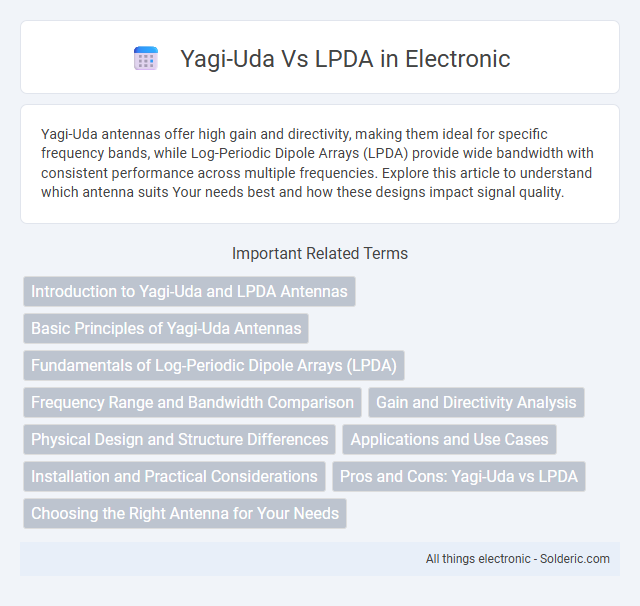Yagi-Uda antennas offer high gain and directivity, making them ideal for specific frequency bands, while Log-Periodic Dipole Arrays (LPDA) provide wide bandwidth with consistent performance across multiple frequencies. Explore this article to understand which antenna suits Your needs best and how these designs impact signal quality.
Comparison Table
| Feature | Yagi-Uda Antenna | Log-Periodic Dipole Array (LPDA) |
|---|---|---|
| Design | Single driven element with multiple parasitic elements (directors and reflectors) | Multiple driven elements of varying lengths arranged logarithmically |
| Frequency Range | Narrowband, optimized for a specific frequency | Wideband, covers broad frequency range (typically 2:1 to 10:1 bandwidth) |
| Gain | High gain (typically 7-20 dBi) | Moderate gain (typically 6-10 dBi), consistent over wide frequencies |
| Directivity | High directivity | Moderate directivity, stable over frequency range |
| Impedance | Varies, often requires tuning or matching | Relatively constant impedance (typically 50 Ohms) |
| Application | TV reception, amateur radio at fixed frequency | Wideband communication, scanning, HF/VHF/UHF antennas |
| Physical Size | Compact for narrow frequency | Longer boom due to multiple elements and wideband design |
| Construction Complexity | Simple, fewer elements | More complex, numerous elements with precise spacing |
Introduction to Yagi-Uda and LPDA Antennas
Yagi-Uda antennas consist of a driven element, reflector, and multiple directors, offering high gain and directional radiation primarily for VHF/UHF bands. Log-Periodic Dipole Array (LPDA) antennas feature a series of dipoles with gradually varying lengths and spacing, providing wide frequency coverage and moderate gain across HF to UHF bands. Yagi-Uda excels in narrowband applications, while LPDA is favored for broadband operation requiring consistent performance.
Basic Principles of Yagi-Uda Antennas
Yagi-Uda antennas consist of a driven element, reflector, and multiple directors arranged in a linear array to achieve high gain and directivity by constructive interference of radio waves. The driven element actively receives or transmits signals, while the reflector and directors help focus the beam, enhancing antenna performance in specific directions. Your choice of a Yagi-Uda antenna benefits applications requiring focused signal reception or transmission with moderate bandwidth and simple design.
Fundamentals of Log-Periodic Dipole Arrays (LPDA)
Log-Periodic Dipole Arrays (LPDA) are broadband antennas characterized by a series of dipole elements with gradually varying lengths and spacings, enabling frequency-independent operation over a wide spectrum. Unlike Yagi-Uda antennas, which rely on specific element lengths and spacings for resonance and directional gain at narrow bands, LPDA designs maintain consistent impedance and directional properties across multiple octaves. This frequency agility makes LPDAs essential for applications such as communications and spectrum monitoring where wideband performance is critical.
Frequency Range and Bandwidth Comparison
Yagi-Uda antennas typically offer narrow bandwidth, optimized for specific frequencies within a limited range, often suitable for VHF and UHF bands. Log-periodic dipole arrays (LPDA) provide wide frequency coverage, supporting multiband operations from HF to UHF due to their frequency-independent design. The LPDA's broader bandwidth enhances versatility in communication systems, while Yagi-Uda antennas excel in gain and directivity within their targeted frequency range.
Gain and Directivity Analysis
Yagi-Uda antennas typically offer higher gain and better directivity within a narrow frequency range due to their multiple parasitic elements, making them ideal for point-to-point communication. Log-Periodic Dipole Arrays (LPDA) provide moderately high gain with wideband directivity across a broad frequency spectrum, ensuring consistent performance over multiple frequencies. Gain values for Yagi-Uda antennas often exceed 10 dBi, whereas LPDAs generally deliver gain around 6-9 dBi but maintain stable directivity over a range of frequencies.
Physical Design and Structure Differences
The Yagi-Uda antenna features a simple design with a driven element, one reflector, and several directors arranged in a linear array, optimizing it for narrowband directional performance. In contrast, the Log-Periodic Dipole Array (LPDA) incorporates multiple dipole elements of varying lengths spaced logarithmically, enabling broadband frequency coverage and consistent directional gain. Your choice depends on whether narrowband precision or wide frequency adaptability best suits your communication needs.
Applications and Use Cases
Yagi-Uda antennas excel in television reception and amateur radio due to their high gain and directional control, making them ideal for fixed installations where precise signal targeting is required. Log-Periodic Dipole Arrays (LPDA) are preferred in broadband applications like spectrum monitoring, RF testing, and communications because they maintain consistent impedance and gain across a wide frequency range. Both antennas serve specialized roles in wireless communication systems, with Yagi-Uda favored for narrowband tasks and LPDA for versatile, multiband operations.
Installation and Practical Considerations
Yagi-Uda antennas are easier to install due to their simpler design and fewer elements, making them suitable for fixed, directional applications with minimal space requirements. LPDA (Log-Periodic Dipole Array) antennas demand more precise alignment and larger mounting structures but offer broader frequency coverage and higher versatility. Choosing between these options depends on your installation environment, frequency needs, and available space for mounting.
Pros and Cons: Yagi-Uda vs LPDA
Yagi-Uda antennas offer high gain and directivity, making them ideal for long-distance communication, but they have a narrow bandwidth and are sensitive to frequency changes. LPDA antennas provide a wide frequency range and consistent performance across bands, though their gain is generally lower compared to Yagi-Uda antennas. Your choice depends on whether you prioritize narrowband high gain or broadband versatility for your application.
Choosing the Right Antenna for Your Needs
When choosing between Yagi-Uda and LPDA antennas, consider that Yagi-Uda antennas provide high gain and directivity, making them ideal for long-distance point-to-point communication. LPDA antennas offer wide bandwidth and consistent performance across a broad frequency range, suitable for applications requiring frequency versatility. Your choice depends on whether you need focused signal directionality or multi-frequency adaptability.
Yagi-Uda vs LPDA Infographic

 solderic.com
solderic.com